BLESSING OF THE BAPTISMAL FONT
The full text for the blessing of the baptismal font can be found here, beginning on page 77 of the file.
After the Prophecies the ministers, servers, and catechumens go to the baptismal font in procession carrying candles, Crucifix, and the Paschal candle as the choir sings the tract "Sicut cervus."
"Sicut cérvus desíderat ad fontes aquárum ita desíderat ánima mea ad te Deus..."
(As the hart panteth for the fountains of waters, so my soul longeth after Thee, my God...)
Psalm 42 (Douay Rheims 41):1
(As the hart panteth for the fountains of waters, so my soul longeth after Thee, my God...)
Psalm 42 (Douay Rheims 41):1
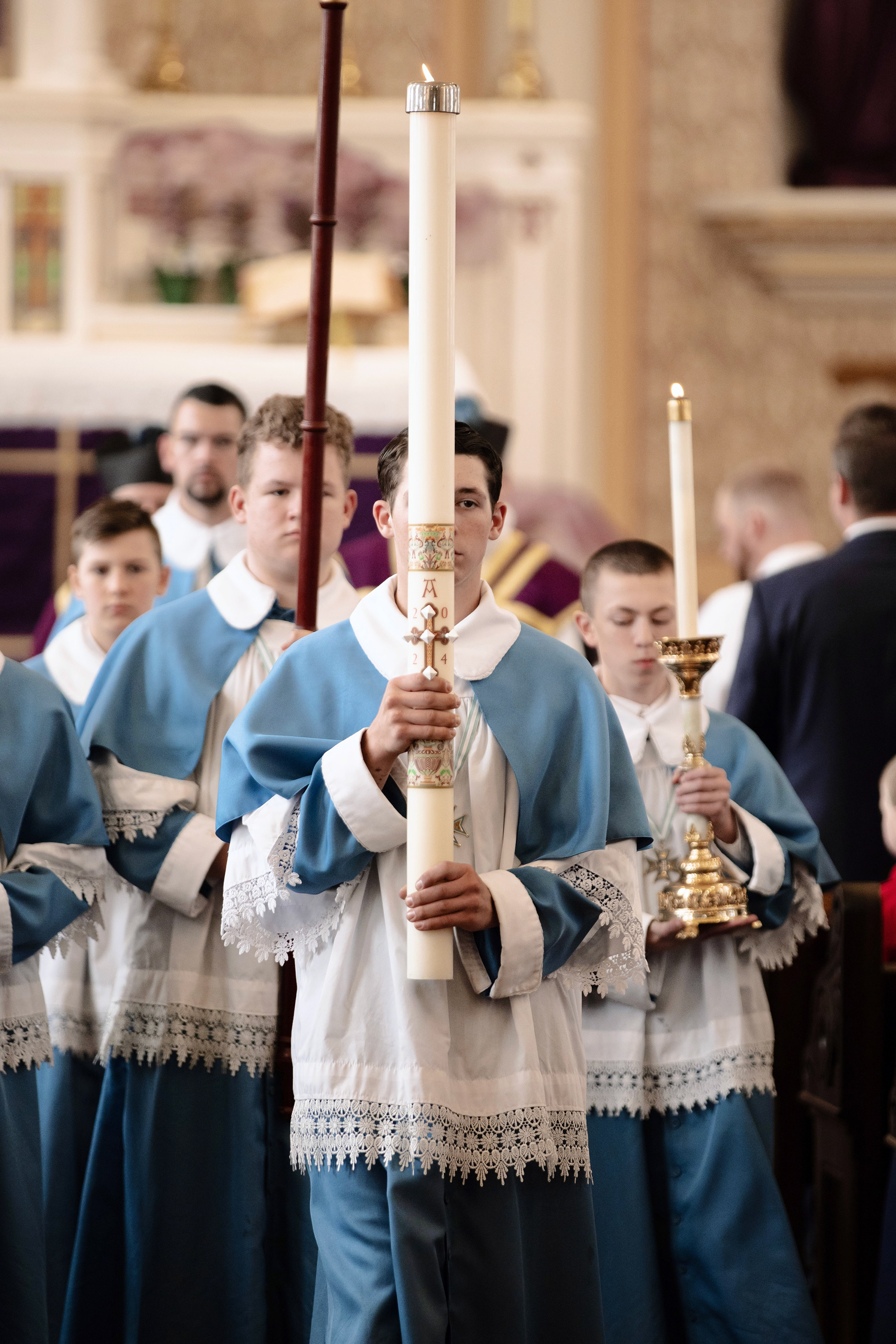
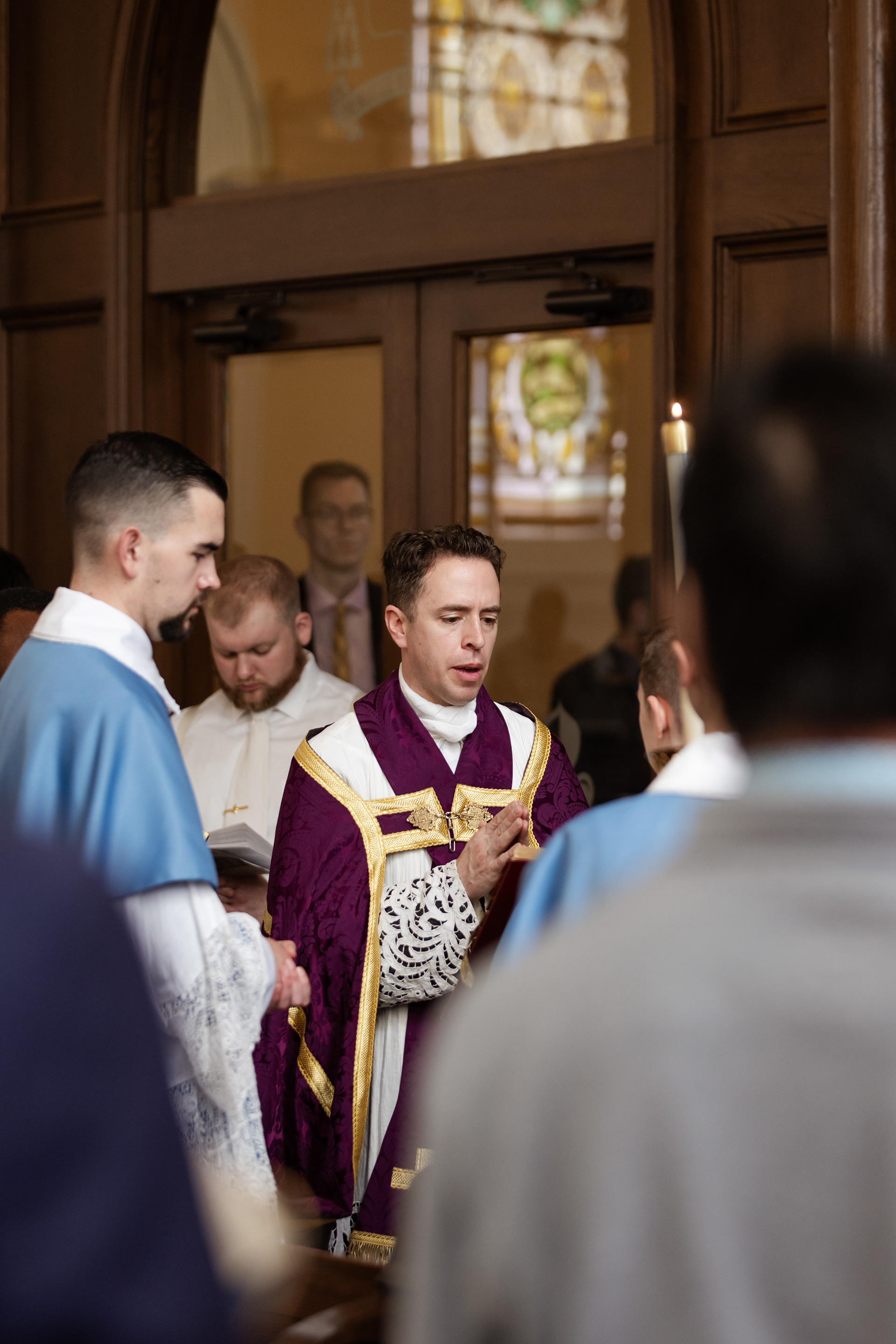
The baptismal water will be blessed, exorcised, and prepared for the baptism of the catechumens.
*Photography Note: The following photos were shot from over the choir loft balcony. I spoke with the rector before the liturgy and was planning on standing on the floor with a window between the servers and the font. As it was, my view was completely obstructed and I had to change my plans on the fly. Providence knows best, and the overhead photos offer a much better view of the ceremonies than photos taken from the nave would have.
Having reached the font, the celebrant sings a Preface in the usual Preface tone, asking God to bestow a blessing upon the baptismal water.
He traces the cross in the water, asking that the Holy Ghost "make fruitful this water that a heavenly offspring may emerge from the immaculate womb of this divine font and that grace as a mother may bring forth every one, how different soever in age or sex, into a like spiritual infancy."
Making a triple Sign of the Cross in the water, he says, "I bless thee, O creature of water, in the name of the living God, of the true God, of the holy God Who, at the beginning, by His word divided thee from the dry land, Whose Spirit was borne upon thee."
Throwing some water in each of the four cardinal directions, "He bade thee to flow from the fountain of paradise and commanded thee to water all the earth in four rivers."
The blessing references the water from the rock (Exodus 17), the miracle at Cana (John 2:1-12), the baptism in the Jordan (Matthew 3:16-17), and the Great Commission (Matthew 28:16-20).
He breathes the shape of a cross into the water and says, "Thou wilt bless [these waters] with Thy mouth, that, besides the natural cleansing which they can perform in the washing of bodies, they may also be efficacious for the purifying of souls."
He then dips the Paschal candle in the water three times, submerging it a little deeper each time. "May the virtue of the Holy Ghost descend upon all the contents of this font."
He breathes on the water three times, tracing the Greek letter psi (Ψ), the first letter of the word for spirit, into it.
He pours some of the newly-blessed water in the aspersorium and sets water aside to fill the holy water fonts, which have been dry since Holy Thursday.
He also pours water for baptisms.
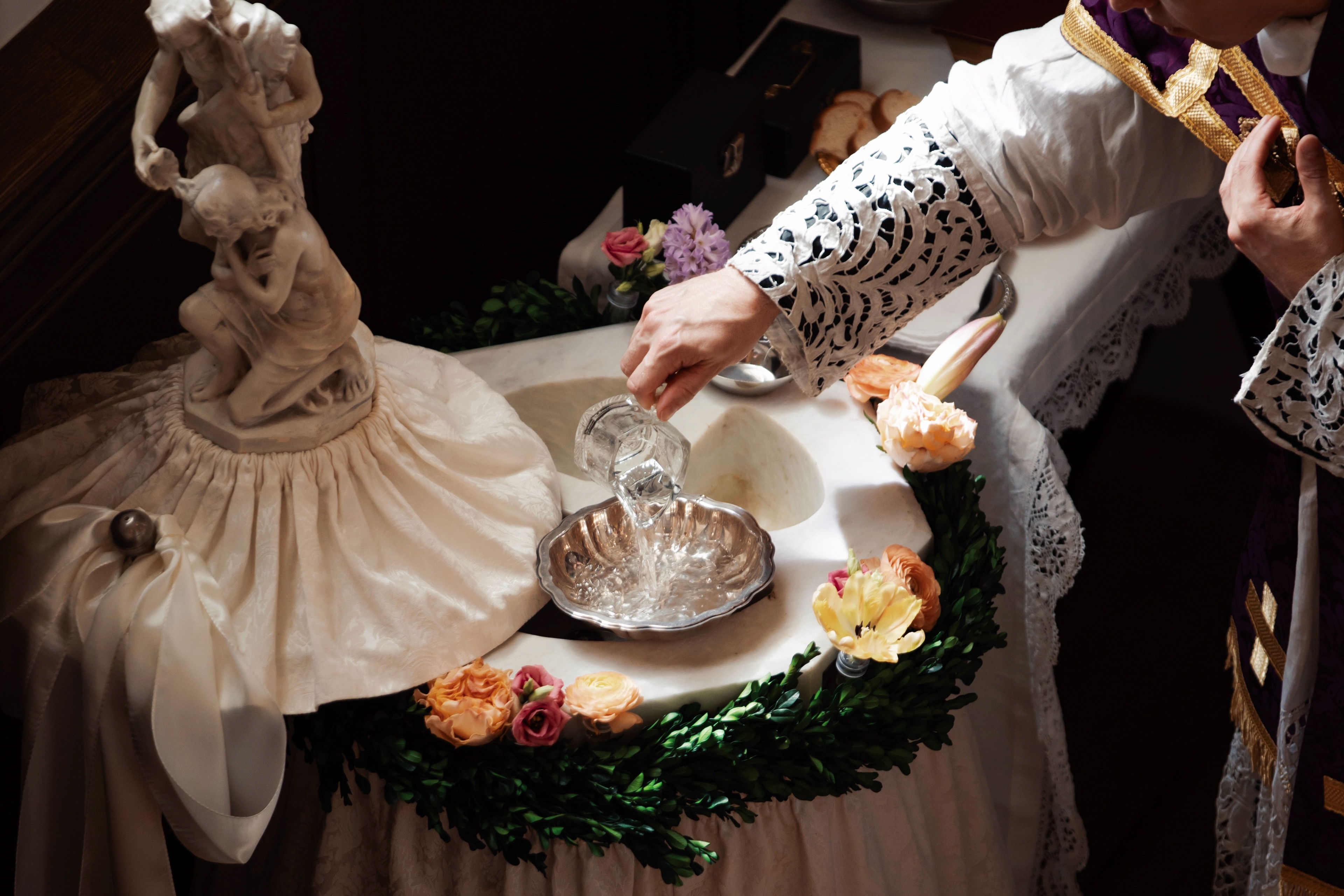
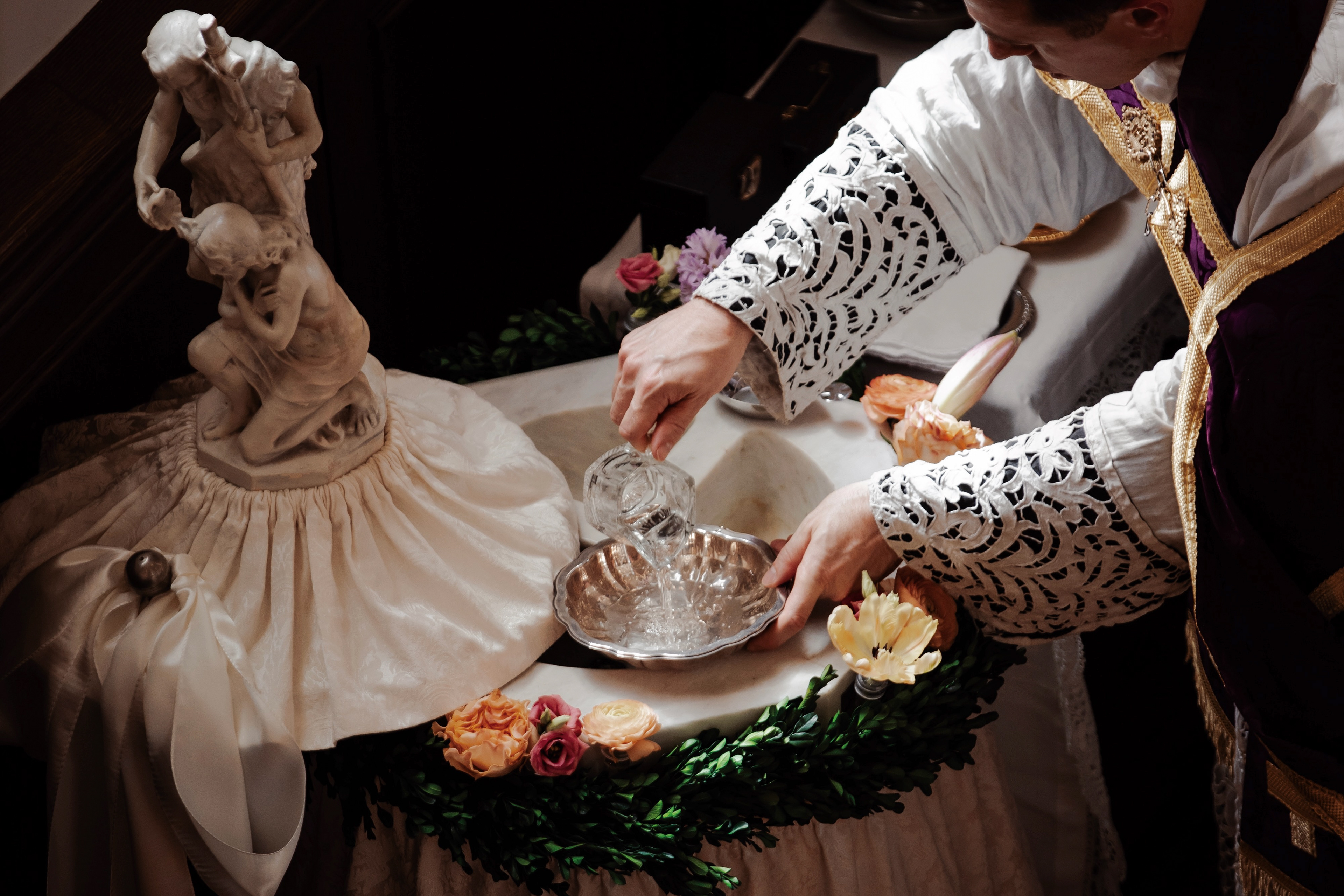
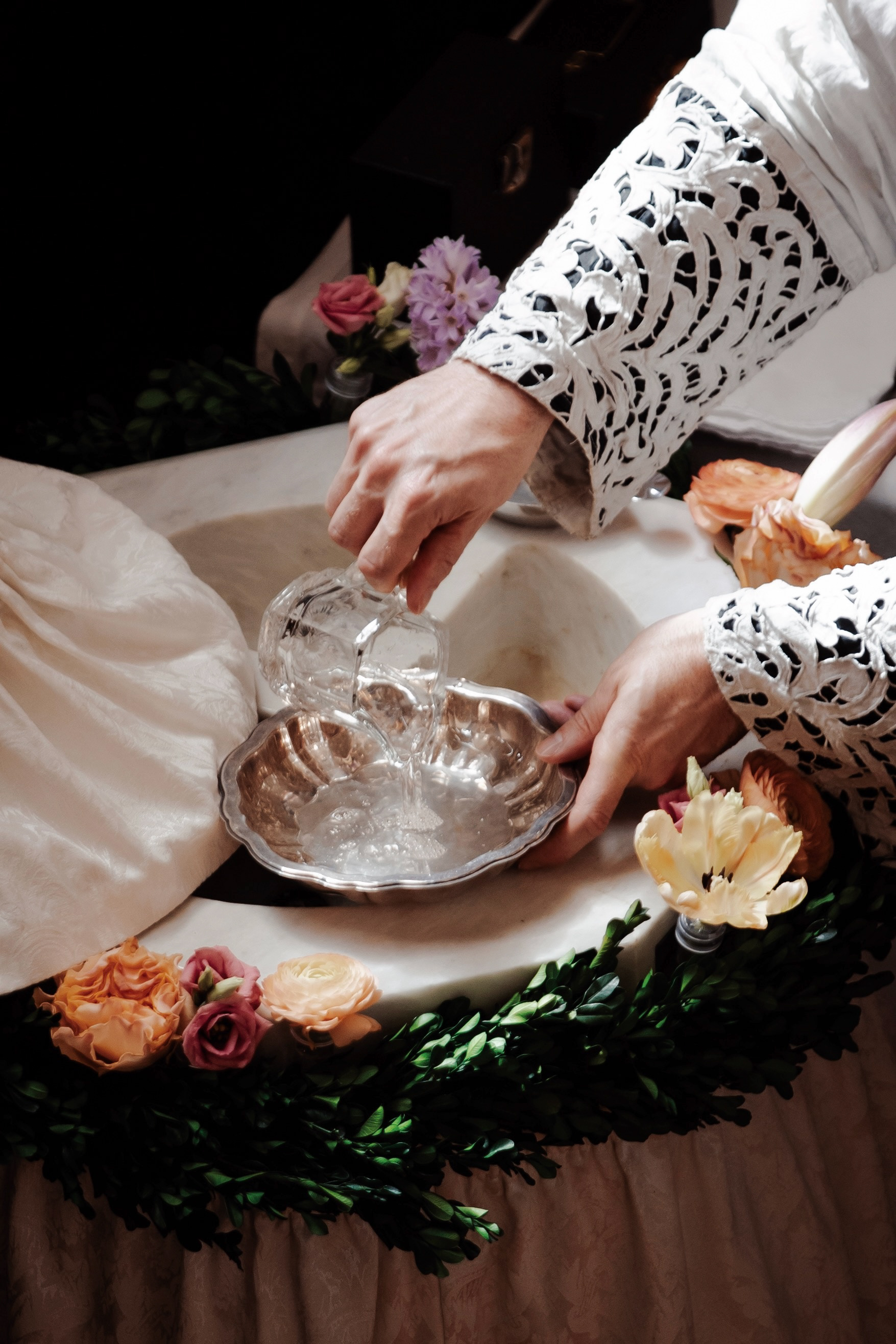
*Photography Note: These shots of the baptismal font are some of my favorites I've ever taken. I was stumped for a while as to how to edit them and I landed on a look inspired by Dutch flower paintings. I don't like to do creative things arbitrarily, but sometimes the artistic decision comes before I find the meaning in it. I think it's fitting that the baptismal font, the birthplace of the sacramental life, be depicted in a way that is reminiscent of flowers: signs of new life.
He sprinkles the people with the water.
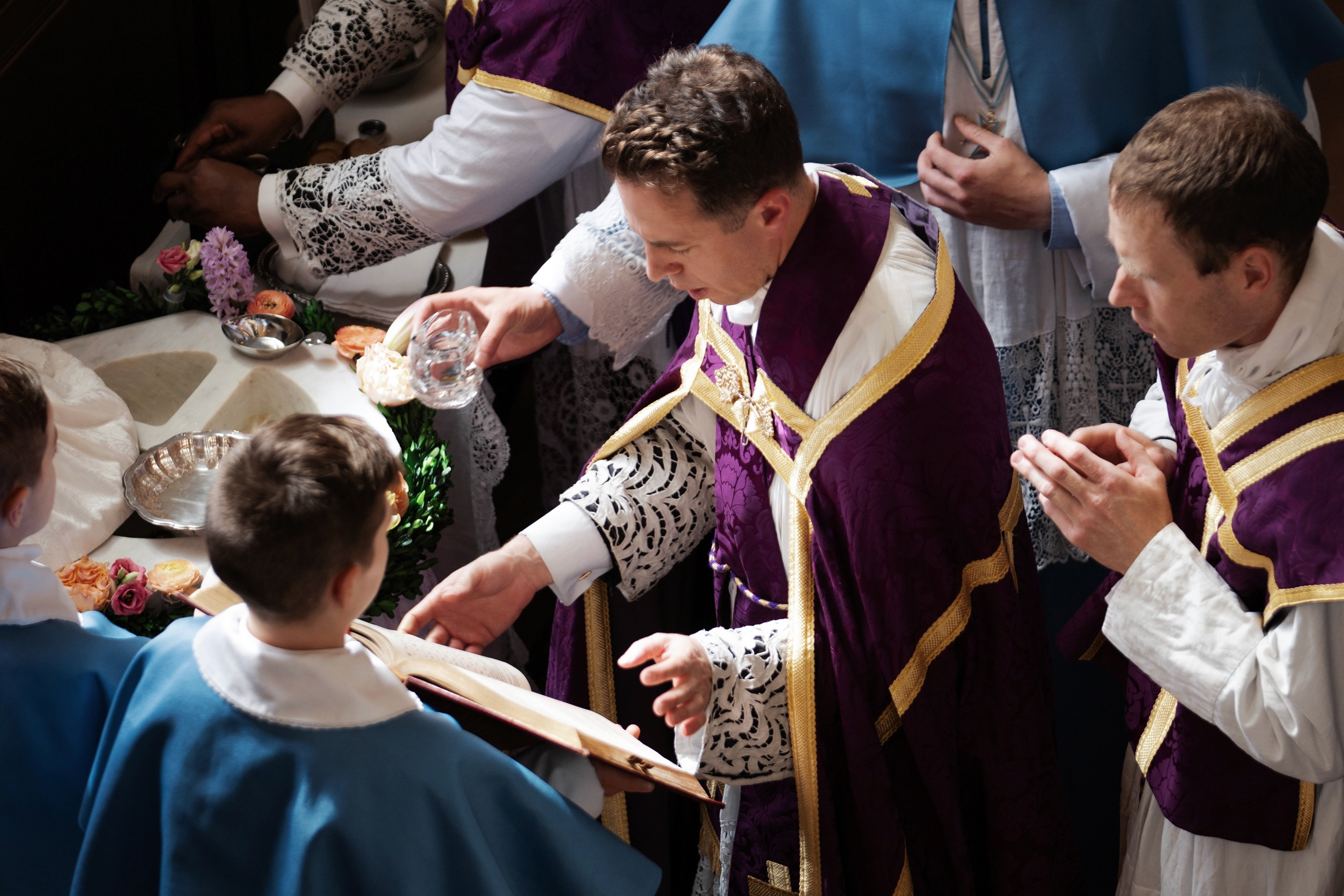
MAKING OF BAPTISMAL WATER
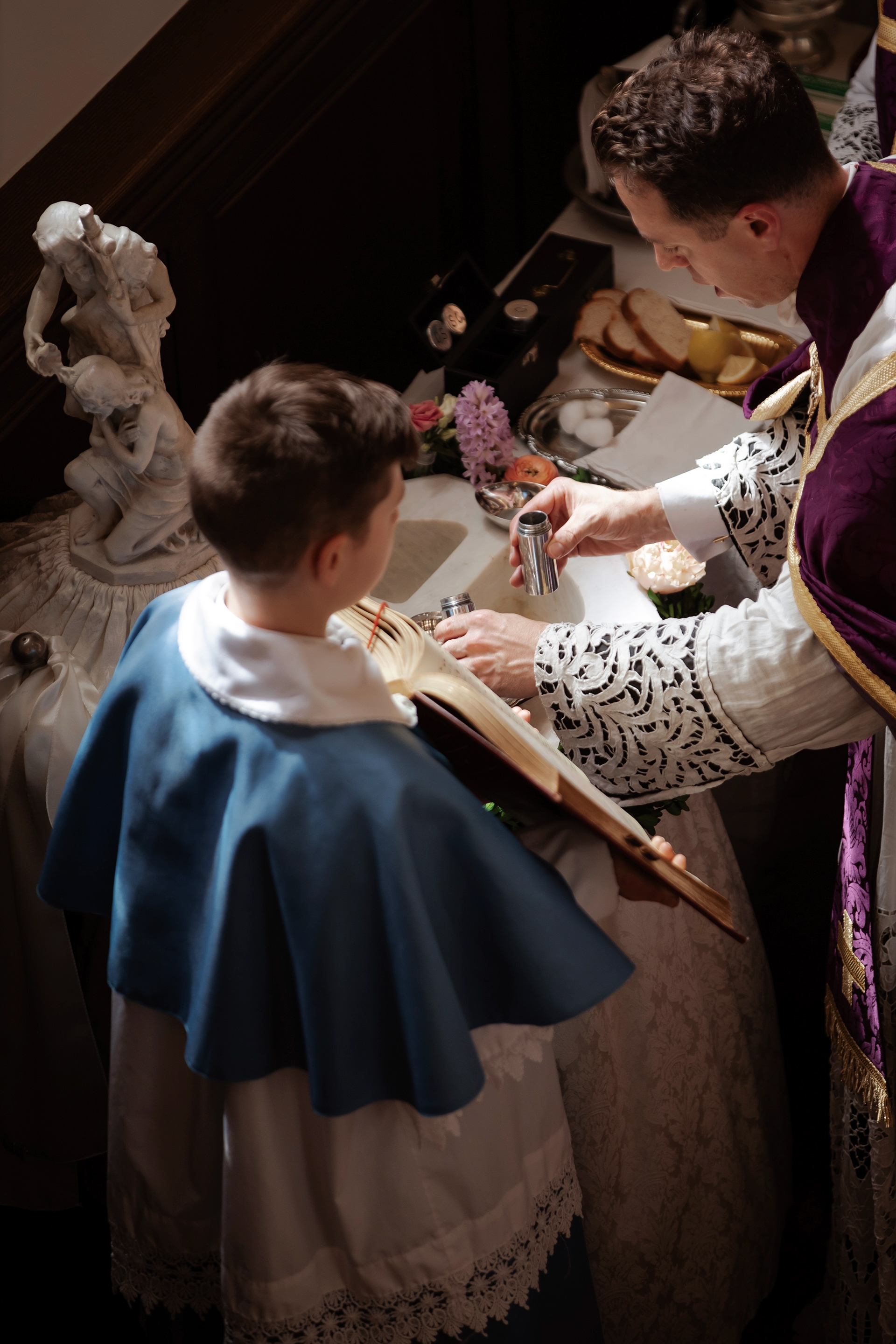
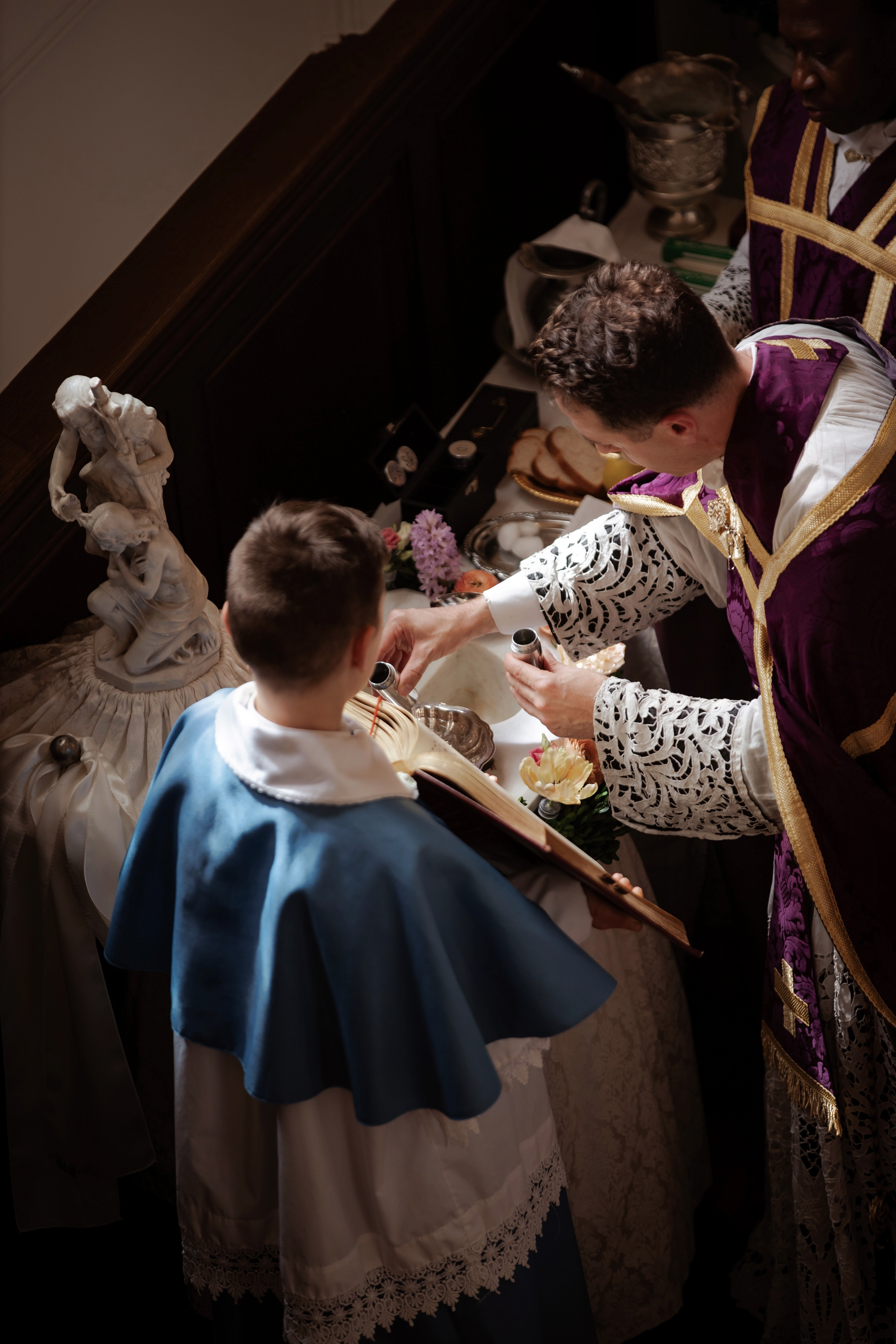
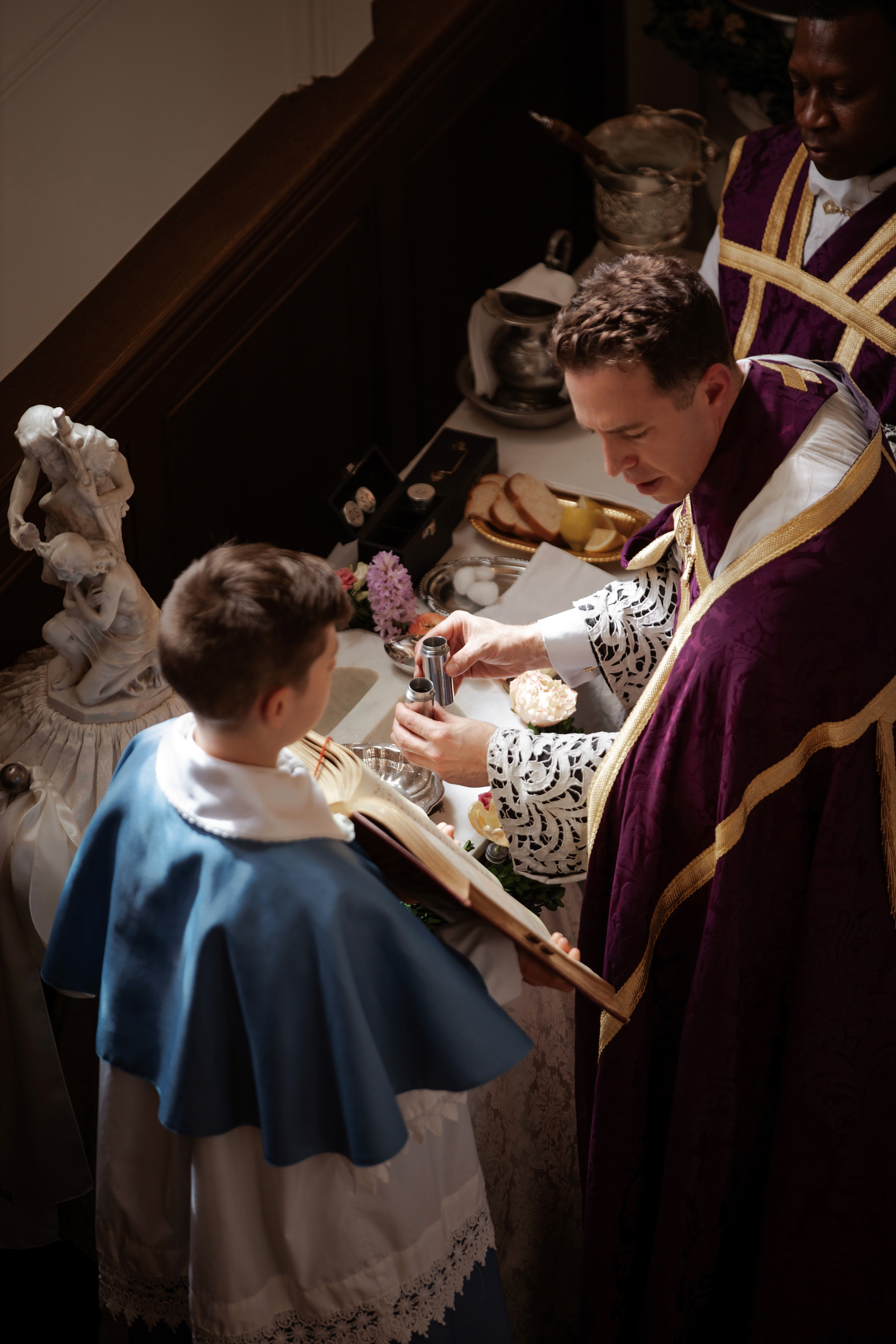
The priest pours chrism and the oil of catechumens into the water, first one at a time and then together, saying, "May the infusion of the chrism of Our Lord Jesus Christ and of the Holy Ghost, the Paraclete, be made in the Name of the Holy Trinity."
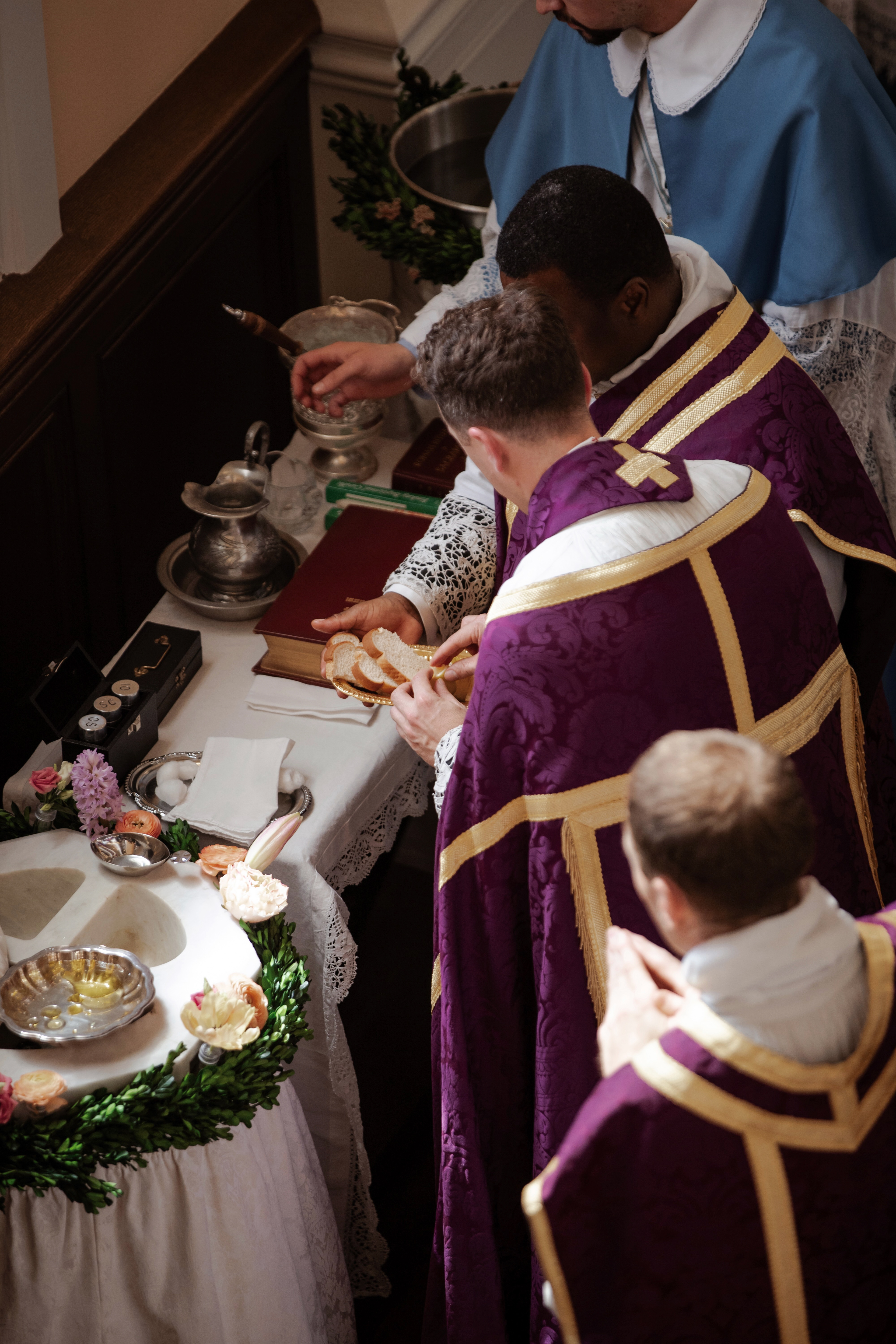
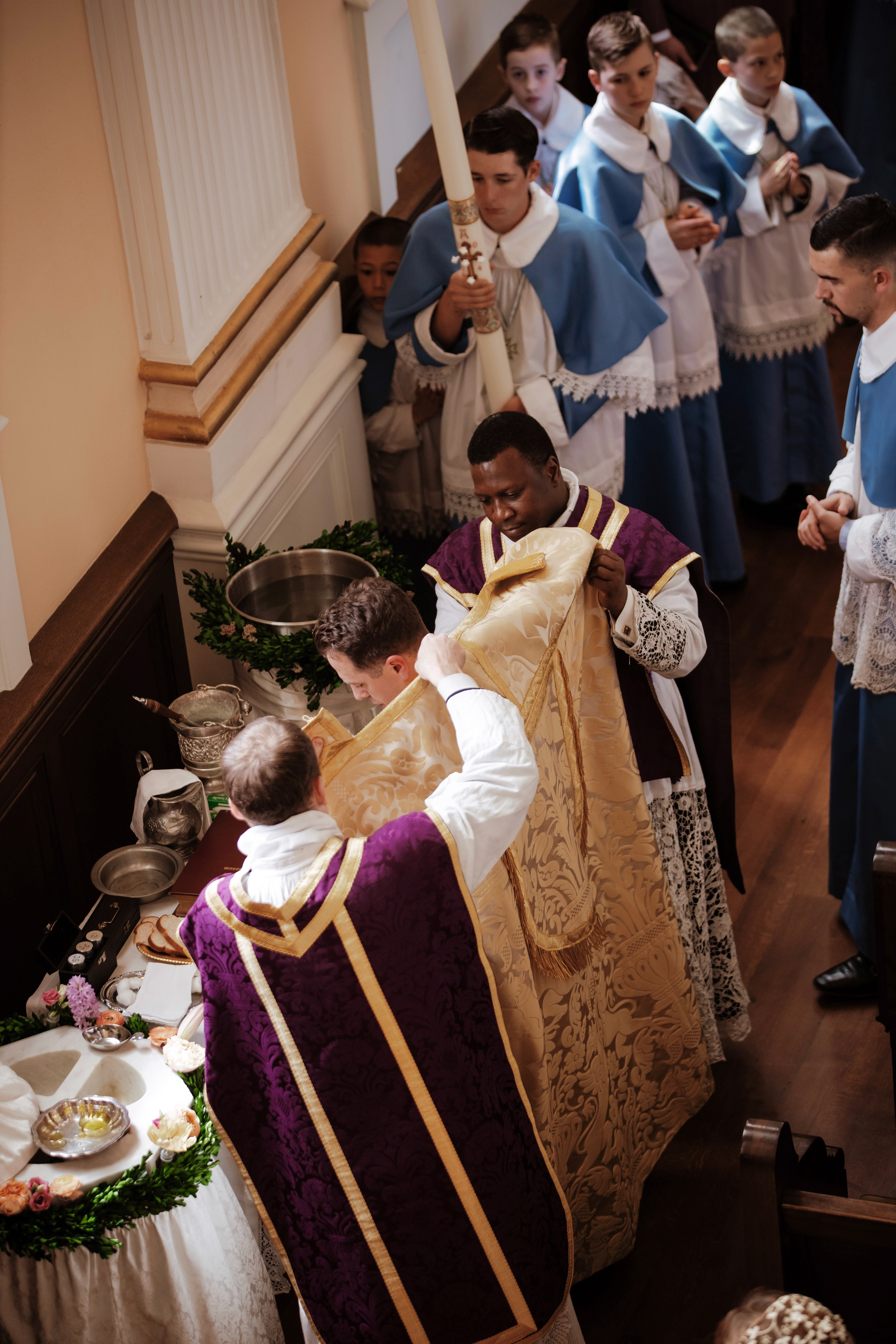
*Liturgy Note: When oil is used during ceremonies (Ash Wednesday, confirmations, etc.), the priest will often use lemons and bread to clean his hands. The lemon juice cuts the oil and the bread absorbs any remaining moisture. These elements can be easily burned later, since it is not appropriate to dispose of sacred chrism in the garbage.
The interrogation of the catechumens took place in the morning. The priest was vested in violet stole as prescribed for the first part of the baptismal ceremonies, and he now changes into white for the baptism itself. The change from violet to white is done at every baptism, no matter the date or the age of the person being baptized.
BAPTISM AND CONFIRMATION OF THE CATECHUMENS
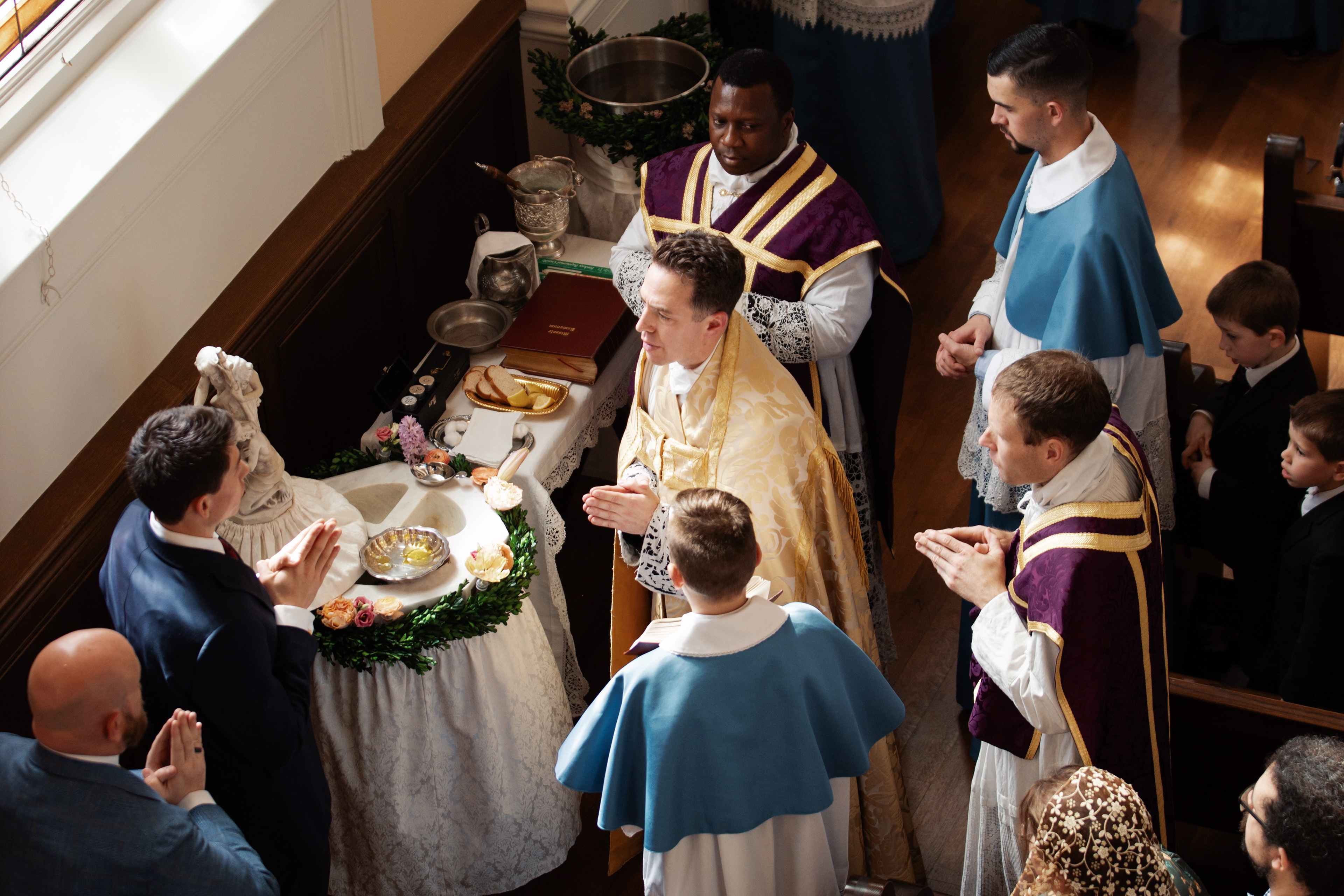
"N., do you wish to be baptized?"
"I do."
"I do."
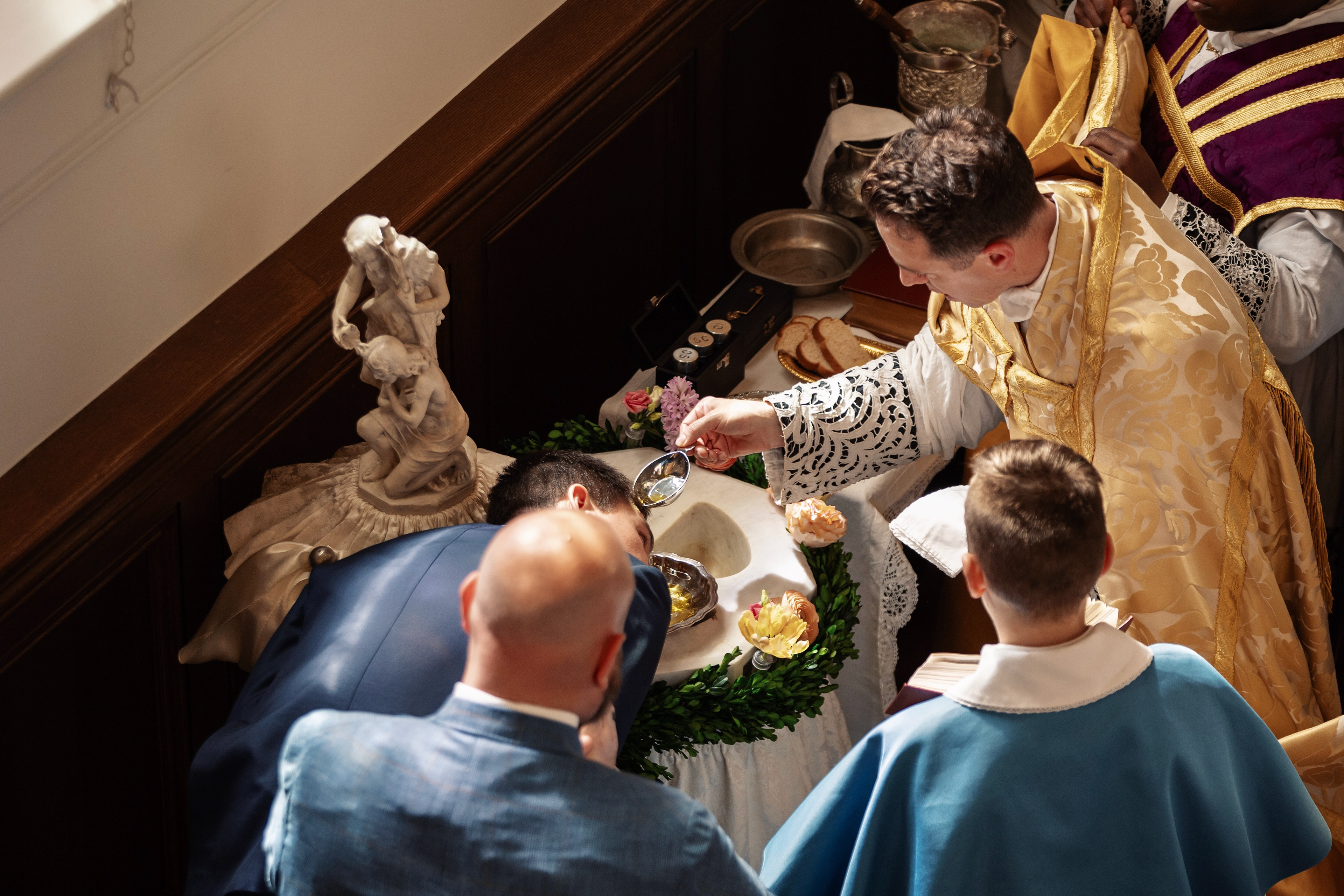
"N., ego te baptizo in nomine Patris, et Filii, et Spiritu Sancti."
|(N., I baptize you in the Name of the Father, and of the Son, and of the Holy Ghost.)
|(N., I baptize you in the Name of the Father, and of the Son, and of the Holy Ghost.)
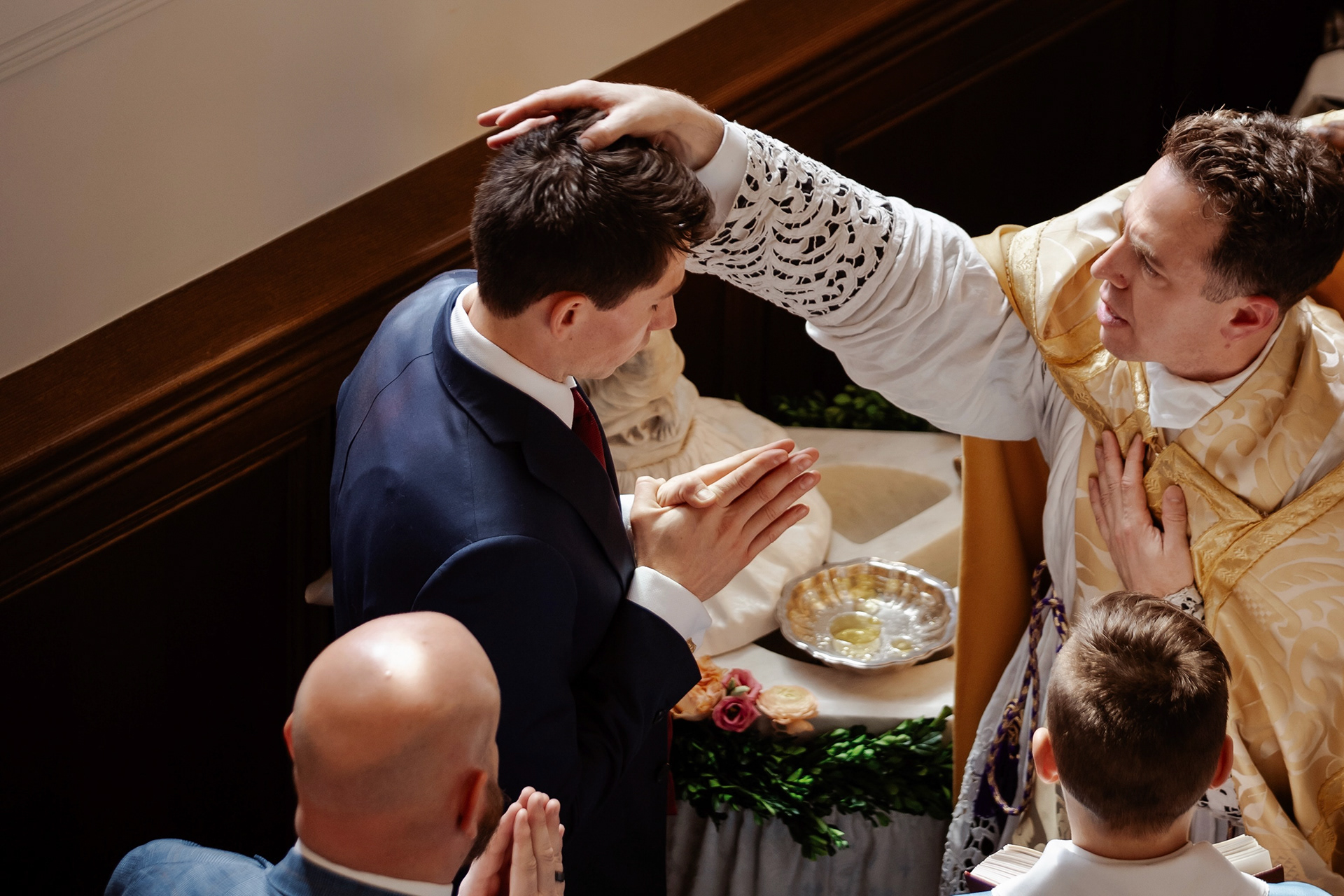
The priest anoints the head of the newly baptized with chrism three times in the form of a cross.
"The almighty God, Father of Our Lord Jesus Christ, has made you to be born again of water and of the Holy Ghost and has given you pardon of your sins. May He now anoint you with the chrism that sanctifies in Jesus Christ Our Lord, and bring you to everlasting life."
He places his hand on the baptismal garment - in this case, the white shirt of the neophyte - and says, "Receive this robe and keep it spotless until you arrive at the judgement seat of Our Lord Jesus Christ, that you may have life eternal."

The priest gives him his baptismal candle.
"Take this burning candle as a reminder to keep your baptismal innocence. Obey the commandments of God, that when Our Lord comes for the joyous wedding feast, you may go forth to meet Him with all the saints in the halls of heaven, and receive life eternal."
The process is repeated for the other catechumen(s).
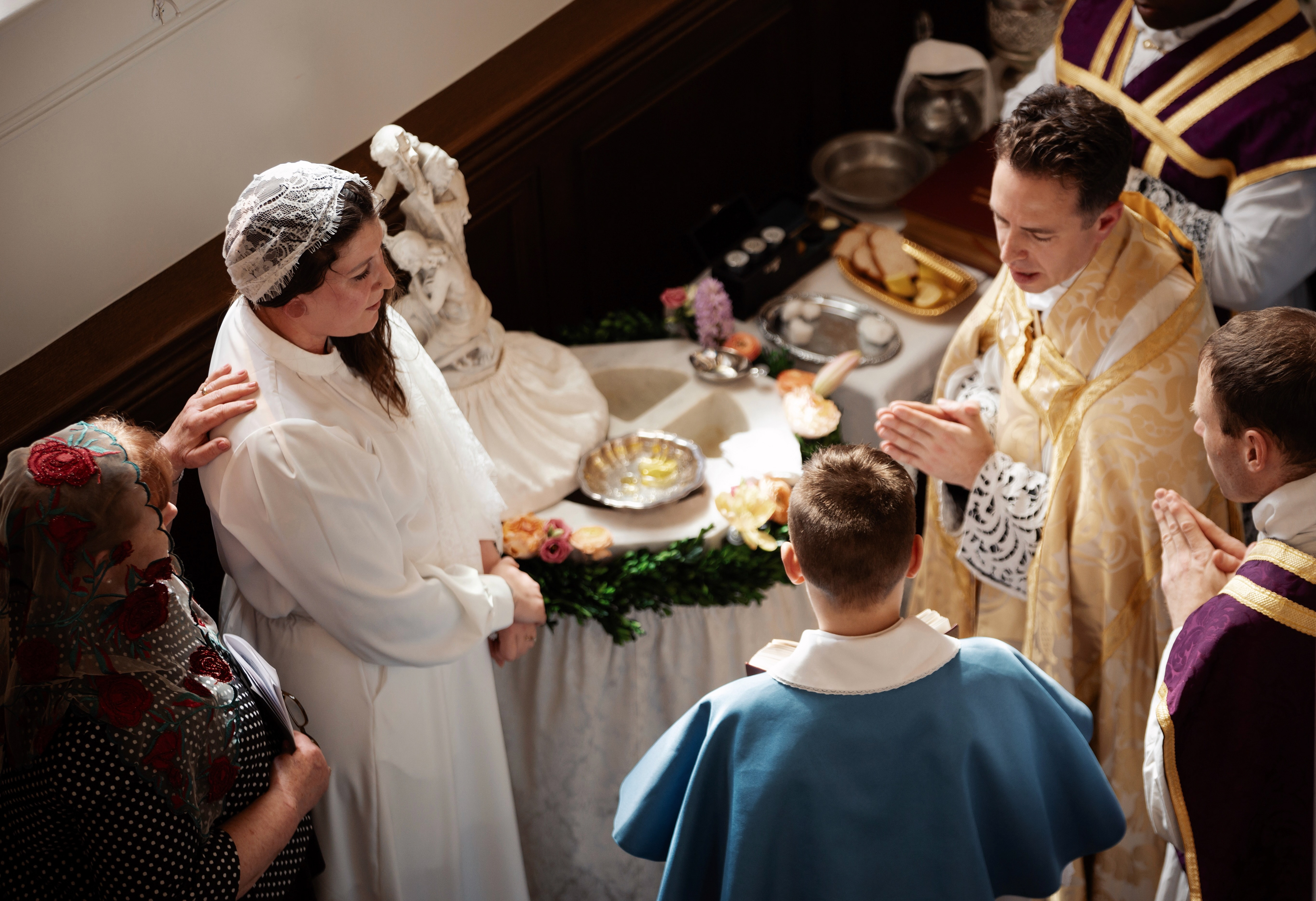
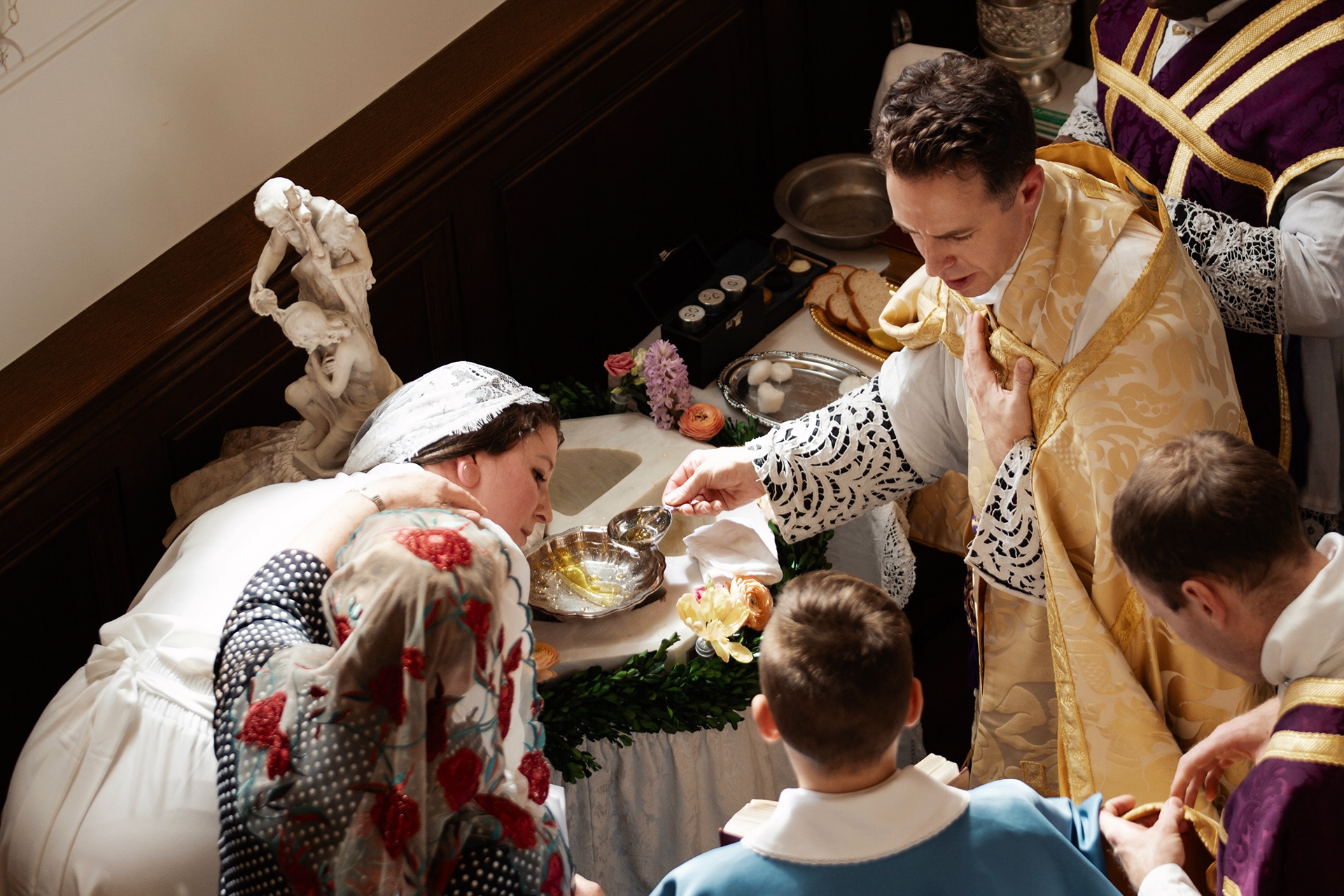
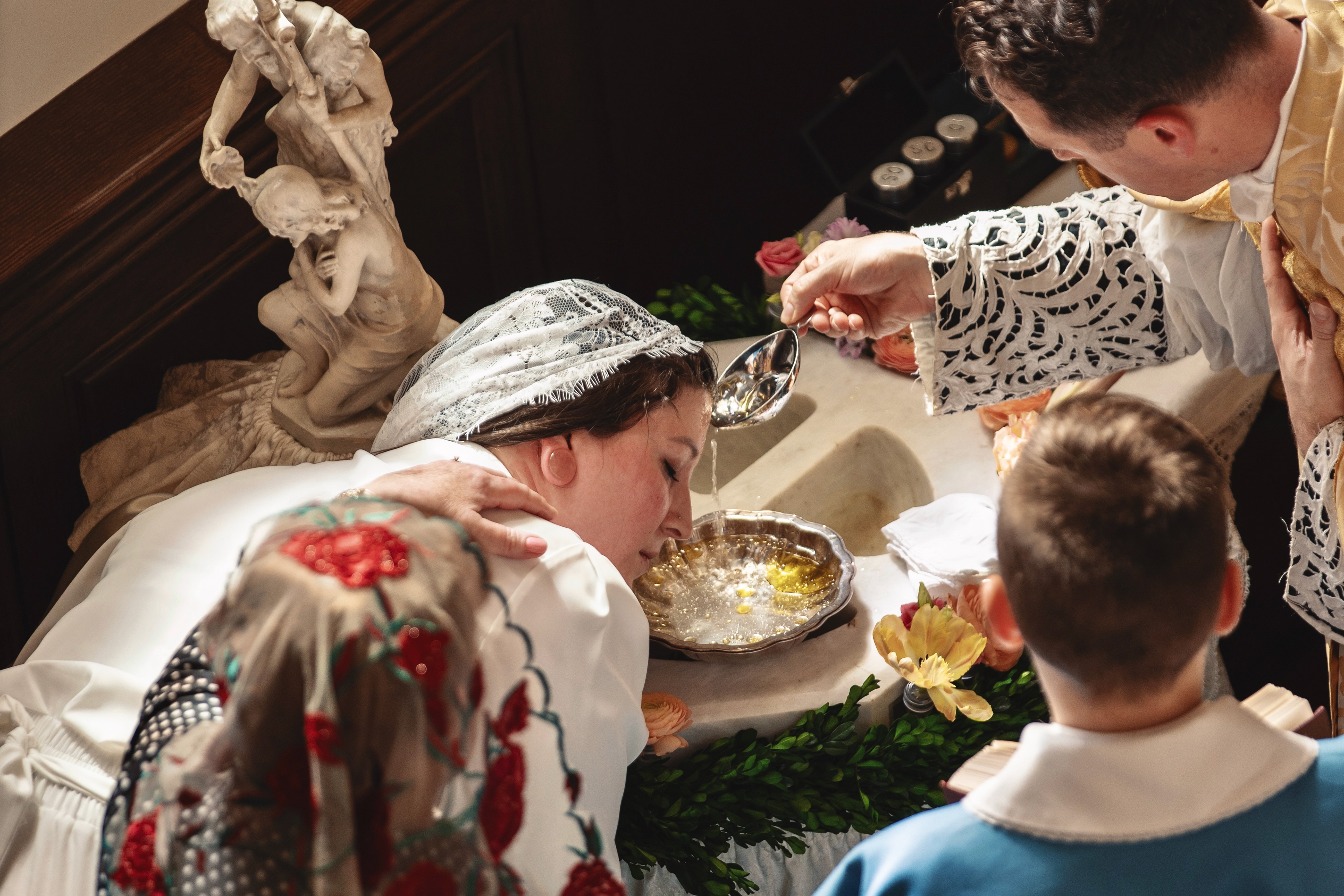
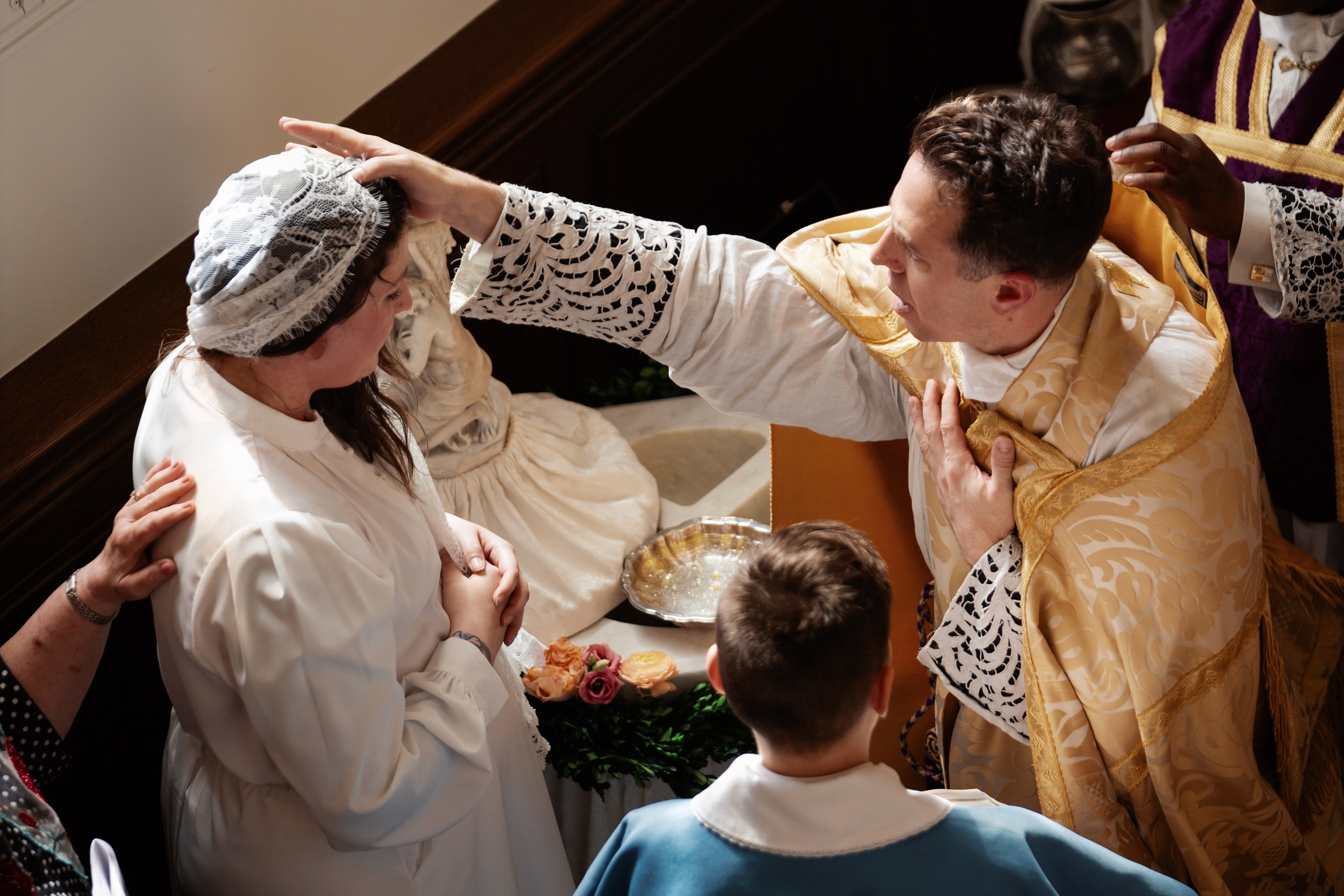
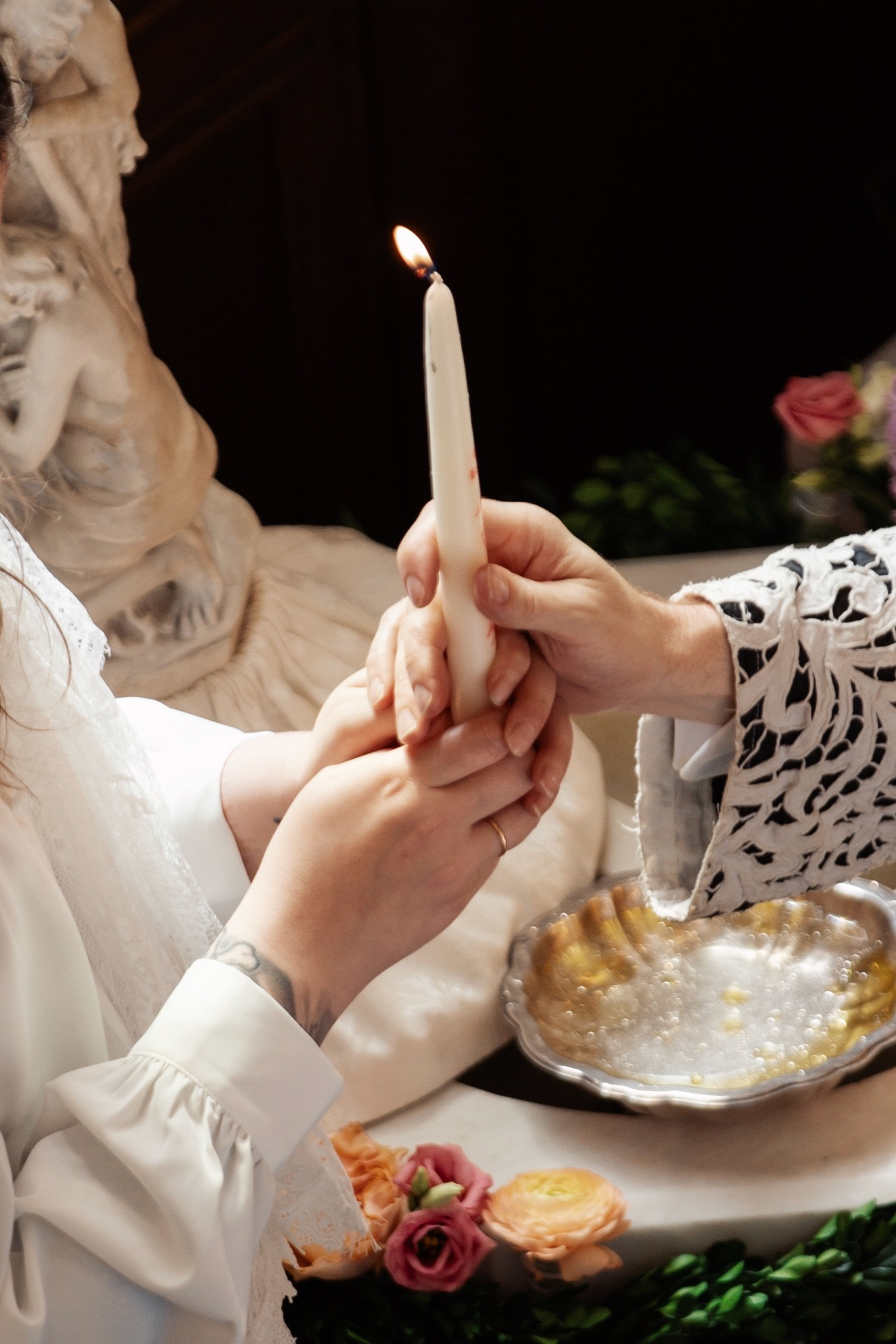
The full ceremony of confirmation can be found here.
The procession returns to the sanctuary.
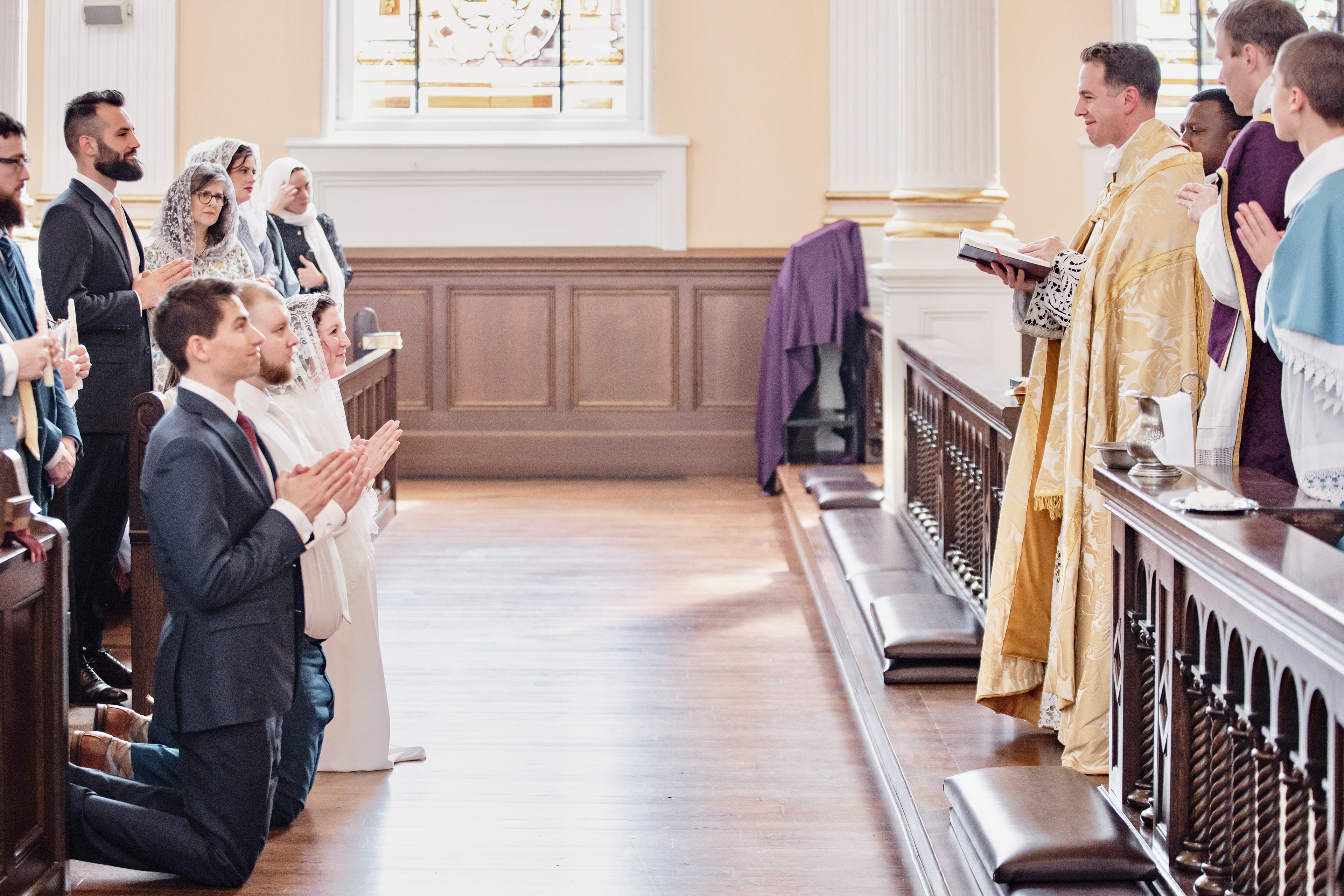
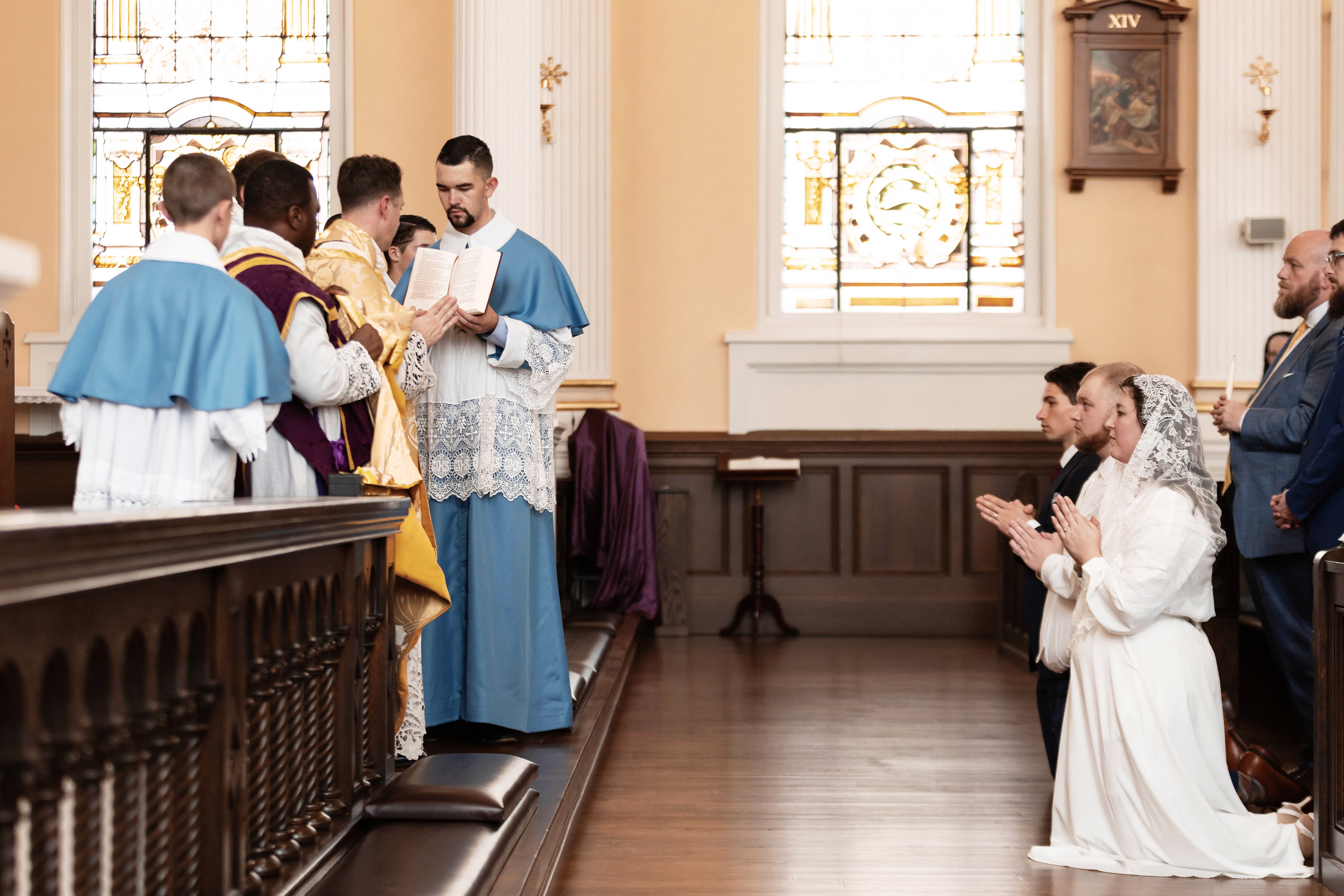
The priest prays that the candidates receive the Holy Ghost and His sevenfold gifts: wisdom, understanding, counsel, fortitude, knowledge, piety, and fear of the Lord.
"N., signo te signo crucis +..."
(N., I sign thee with the Sign of the Cross...)
(N., I sign thee with the Sign of the Cross...)
"...et confirmo te chrismate salutis..."
(... and I confirm thee with the chrism of salvation...)
(... and I confirm thee with the chrism of salvation...)
"...in nomine Patris + et Filii + et Spiritus + Sancti."
(...in the Name of the Father, and of the Son, and of the Holy Ghost.)
(...in the Name of the Father, and of the Son, and of the Holy Ghost.)
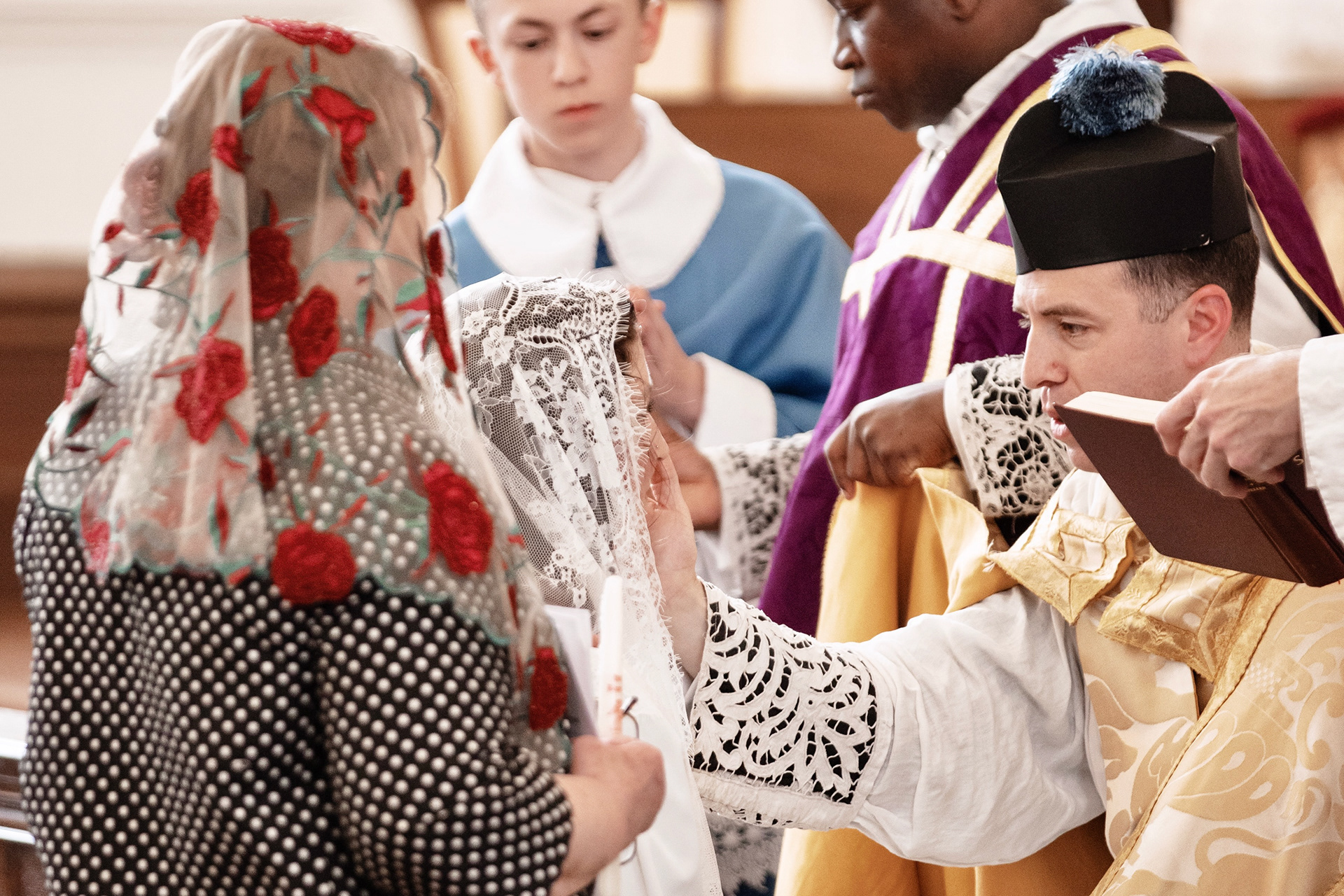
Saying, "Pax tecum" (peace be with you), he gently strikes the candidate on the cheek, symbolizing that she is now a soldier of Christ and must endure suffering.
He cleanses his hands again with bread and lemons.
A final blessing is made over the newly confirmed. He is seated as all in attendance recite the Apostles Creed, the Our Father, and the Hail Mary.
THE LITANY OF SAINTS
Immediately following the confirmations, the clergy return to the sanctuary. They remove the cope and folded chasubles and lay prostrate before the altar as the Litany of Saints is sung.
The Litany is doubled, meaning that each line is sung twice. In the days that there were great numbers of people baptized at the Vigil, the Litany was sung during the baptisms, once with seven repetitions of each line, again with five repetitions, and again with three. The doubled Litany after the imposition of the sacraments is the maintaining of that tradition.
The Litany is doubled, meaning that each line is sung twice. In the days that there were great numbers of people baptized at the Vigil, the Litany was sung during the baptisms, once with seven repetitions of each line, again with five repetitions, and again with three. The doubled Litany after the imposition of the sacraments is the maintaining of that tradition.
After the saints' names have all been sung, the clergy rise and go to the sacristy to vest in white for Mass while the Litany continues.
During the petitions for protection and deliverance, the servers prepare the altar and remove the violet antependium and cloth on the floor.